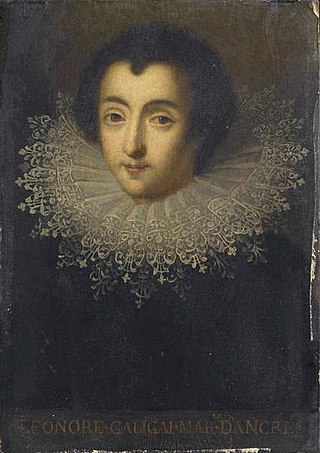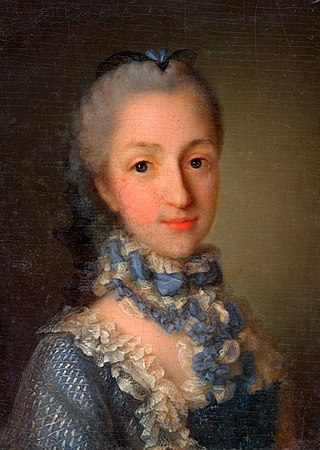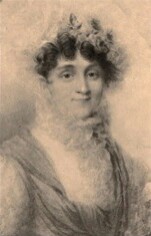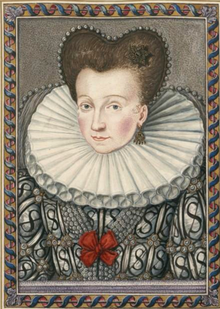
Jeanne Bécu, Comtesse du Barry was the last maîtresse-en-titre of King Louis XV of France. She was executed by guillotine during the French Revolution on accusations of treason — particularly being suspected of assisting émigrés to flee from the Revolution. She is also known as "Mademoiselle Vaubernier".

Jeanne Louise Henriette Campan was a French educator, writer and Lady's maid. In the service of Marie Antoinette before and during the French Revolution, she was afterwards headmistress of the first Maison d'éducation de la Légion d'honneur, appointed by Napoleon in 1807 to promote the education of girls.

Anne d'Arpajon, comtesse de Noailles was a French noblewoman and court official. She served as the dame d'honneur of two Queens of France, Marie Leszczyńska and Marie Antoinette. She was called "Madame Etiquette" by Marie Antoinette for her insistence that the minutiae of court etiquette could never be altered or disregarded.

The maîtresse-en-titre was the official royal mistress of the King of France. The title was vaguely defined and used in the Middle Ages but finally became an acknowledged, if informal, position during the reign of Henry IV, and continued through the reign of Louis XV. It was a semi-official position which came with its own apartments, estates and a title if the woman did not have any.

Jacqueline de Longwy, Countess of Bar-sur-Seine, Duchess of Montpensier, Dauphine of Auvergne was a French noblewoman, and a half-niece of King Francis I of France. She was the first wife of Louis III de Bourbon, Duke of Montpensier, and the mother of his six children. She had the office of Première dame d'honneur to the queen dowager regent of France, Catherine de' Medici, from 1560 until 1561.

Jeanne d'Angoulême, Countess of Bar-sur-Seine, Dame de Givry, Baroness of Pagny and of Mirebeau, was a half-sister of King Francis I of France and princess Marguerite de Navarre. She was created suo jure Countess of Bar-sur-Seine in 1522. She was the wife of Jean de Longwy, Seigneur of Givry, Baron of Pagny and of Mirebeau.

Madame du Barry is a 1954 French-Italian historical drama film directed by Christian-Jaque and starring Martine Carol, Daniel Ivernel, Gianna Maria Canale and Jean Parédès. The film depicts the life of Madame du Barry, mistress to Louis XV in the eighteenth century. It was shot at the Saint-Maurice Studios in Paris. The film's sets were designed by the art director Robert Gys.
The governess of the children of France was an office at the royal French court during pre-Revolutionary France and the Bourbon Restoration. As the head of the royal nursery, she was charged with the education of the children and grandchildren of the monarch. The holder of the office was taken from the highest-ranking nobility of France and was passed between female family members for much of its history by right of succession (survivance). The governess was supported by various deputies or under-governesses and oversaw a household consisting of dozens of servants and caregivers.
Lise Delamare was a French stage and film actress.

Women letter writers in early modern Europe created lengthy correspondences, where they expressed their intellect and their creativity; in the process, they also left a rich historical legacy.

Marguerite Moreno was a French stage and film actress.

Première dame d'honneur, or simply dame d'honneur, was an office at the royal court of France. It existed in nearly all French courts from the 16th-century onward. Though the tasks of the post shifted, the dame d'honneur was normally the first or second rank of all ladies-in-waiting. The dame d'honneur was selected from the members of the highest French nobility.

Dame d'atour was an office at the royal court of France. It existed in nearly all French courts from the 16th-century onward. The dame d'honneur was selected from the members of the highest French nobility. They were ranked between the Première dame d'honneur and the Dame du Palais.

Laure Auguste de Fitz-James, Princesse de Chimey was a French courtier. She served as lady-in-waiting to Queen Marie Antoinette from 1770 to 1791.

Françoise de Chalus, was a French noblewoman and courtier. She was the mother of Louis, comte de Narbonne-Lara, possibly by king Louis XV of France. She was the lady-in-waiting of Louise Élisabeth of France in 1749–59, and the influential favorite lady-in-waiting of Princess Marie Adélaïde of France in 1764–1800.

Marie Catherine de Senecey née de La Rochefoucauld (1588–1677) was a French courtier. She served as Première dame d'honneur to the queen of France, Anne of Austria, from 1626 until 1638, and royal governess to king Louis XIV of France and his brother from 1643 until 1646.

Jeanne Charlotte du Luçay née Papillon d'Auteroche (1769-1842), was a French court official, Dame du Palais to Empress Joséphine and Dame d'atour to Empress Marie Louise of France.

Émilie de Beauharnais, comtesse de Lavalette (1781–1855), was a French court official, dame d'atour to Empress Joséphine of France.

The Brûlart family was a family of the French nobility that was established in Paris, in the service of the Kings of France, which then relocated to Burgundy. It is said to have originated from Saint-Martin-d'Ablois, the Marne department in Champagne. The Brûlart family died out in 1793 upon the extinction of the Genlis branch.


























